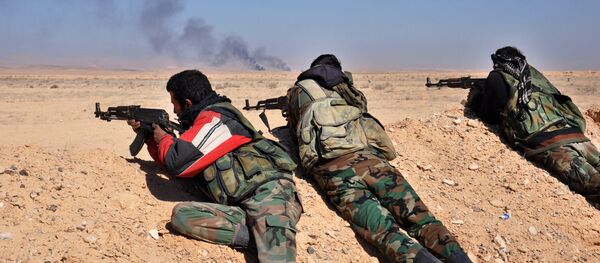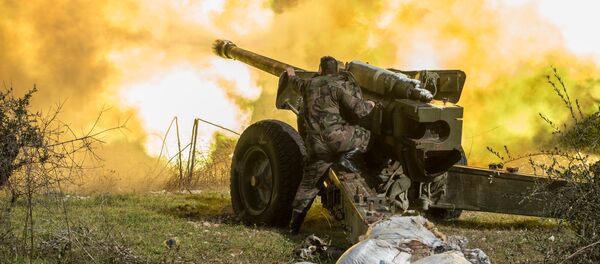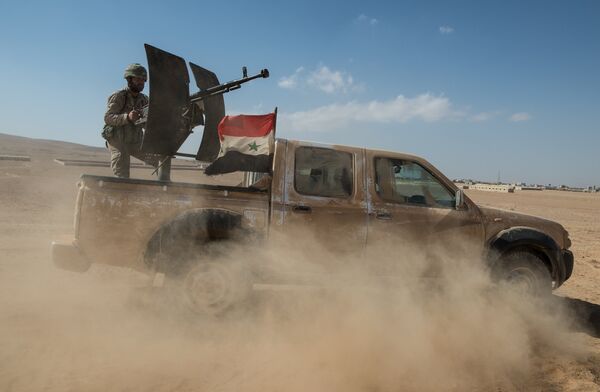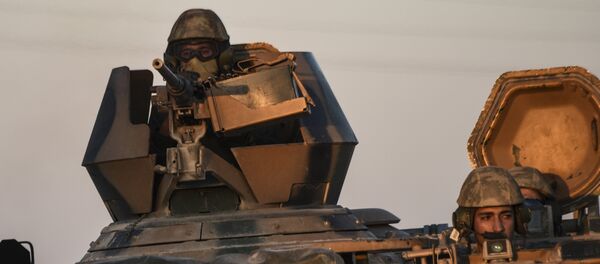The Syrian Arab Army (SAA) has managed to liberate the entire town of al-Sukhnah, the main stronghold of Daesh (ISIS/ISIL) in the Homs province, a local source told Sputnik on Saturday; the significance of the latest developments on the ground could hardly be overestimated: having regained control over the town the SAA will launch an all-out offensive against Deir ez-Zor from the west, Sputnik contributor Andrei Kots writes.
The vanguard of the Syrian Arab Army (SAA) entered al-Sukhnah last Sunday. The assault detachments of the SAA initiated a sweep of the town. During this week the Syrian government forces have been moving to the center of the settlement, liberating it district by district. The Syrian Army completely surrounded the town a few days before the final offensive.
Al-Sukhnah, a Syrian town with a population of about 15,000 people, is located in the Syrian desert, 70 kilometers (43.5 mi) northeast of Palmyra.
"[Al-Sukhnah] is the only large population center in the east of the province of Homs; it occupies a strategically important position located on a hill near the M-20 highway," Kots elaborated.
By maintaining control over this major transport artery the SAA will be able to quickly move troops, equipment, ammunition and food to the east of Syria, Kots highlighted.
"Daesh was perfectly aware of the significance of al-Sukhnah two years ago," the journalist recalled. "They managed to take the town on May 13, 2015, following several unsuccessful attempts. The capture of al-Sukhnah was part of the terrorists' full-scale offensive against Palmyra. The SAA troops held the town to the last but had to retreat with 70 soldiers killed."
The first thing Daesh did after taking al-Sukhnah was the cruel execution of 26 town dwellers, he added.
The terrorists managed to seize Palmyra a week later, on May 20, 2015.
"Al-Sukhnah was successfully used by Daesh as a foothold for [military actions] in the west and southwest of the country," Kots noted.
Today, the situation is being repeated in reverse: after retaking Palmira from Daesh for the second time in February 2017, the SAA troops backed by the Russian Aerospace Forces carried out an offensive along the M-20 and by the end of July reached the town of al-Sukhnah.
"The economic aspect of the [SAA] operation is of utmost importance," Kots pointed out. "There is a large natural gas field near the town. Taking it under the control of the SAA will deprive Daesh of a significant source of profit."
According to Kots, after taking hold of al-Sukhnah the Syrian government forces will move eastward.
Deir ez-Zor is located about 130 kilometers (80.77 mi) from al-Sukhnah. While the distance seems rather small, the advance toward Deir ez-Zor will be no walk in the park for the Syrian armed forces.
"However, it will be much more difficult for [Daesh] to covertly move their forces across the [Syrian] desert for long distances: being deprived of any shelter they will be extremely vulnerable to air attacks," Kots noted, expressing confidence that the Russian Aerospace Forces, as well as the Syrian Army Air Force, will take advantage of the situation to attack the terrorists.
In addition, the SAA units have already started their advance on Deir ez-Zor from the north, along the Euphrates River bank, the journalist noted.
"Thus, very soon, [the Syrian] government troops will be able to launch a pincer drive against Deir ez-Zor from the two directions," he stressed.
"It is Palmyra that the SAA is planning to use to send its main force to lift the blockade of Deir ez-Zor and push Daesh out of the city," Konovalov said. "Daesh understands that they are likely to lose Raqqa, their de facto capital. They are determined to turn Deir ez-Zor into their new stronghold. This is why the areas around Palmyra are some of the most complex operational theaters."
Meanwhile, the battle for Raqqa continues with about two thousand terrorists still remaining in the city.
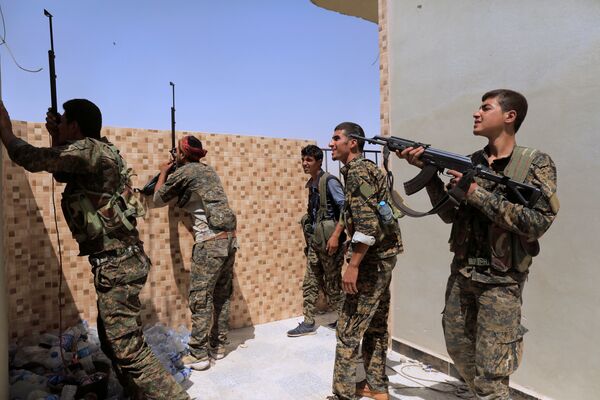
Citing Brett McGurk, US special envoy for the coalition against the Islamic State, Reuters reported on August 4 that the Kurdish-dominated Syrian Democratic Forces (SDF) "had cleared about 45 percent of Raqqa since launching an attack in early June" to retake the city from the terrorist organization.
"With the fall of Raqqa, Deir ez-Zor will remain the only major city over which Daesh retains partial control," Kots wrote. "The liberation of the city will be not just the biggest military success, but also a great image victory for [Syrian President] Bashar al-Assad."
The Sputnik contributor recalled that a small garrison comprised of SAA troops, police and local militia has been steadfastly holding the western part of Deir ez-Zor and the military airfield for almost two years, fighting in the complete encirclement.
Still, the defeat of Daesh won't mean the end of the battle for Syria's sovereignty: in late July Hayat Tahrir al-Sham (HTS), the successor of al-Qaeda's affiliate al-Nusra Front, seized the Syrian city of Idlib.
Commenting on the issue, Gevorg Mirzayan, an associate professor at the department of political science at the Finance University of the Russian Government, highlighted the necessity of liberating Deir ez-Zor and Raqqa from Daesh for the SAA in order to retake Idlib from the terrorists.
"First, [Bashar al-Assad] will control the agricultural lands of Raqqa and the oil fields of Deir ez-Zor. Second, he will have access to the Iraqi border, through which he will be able to receive reinforcements from the 'Iraqi volunteers' controlled by Tehran. Third, he will be able to concentrate all available troops against Idlib," Mirzayan underscored.

